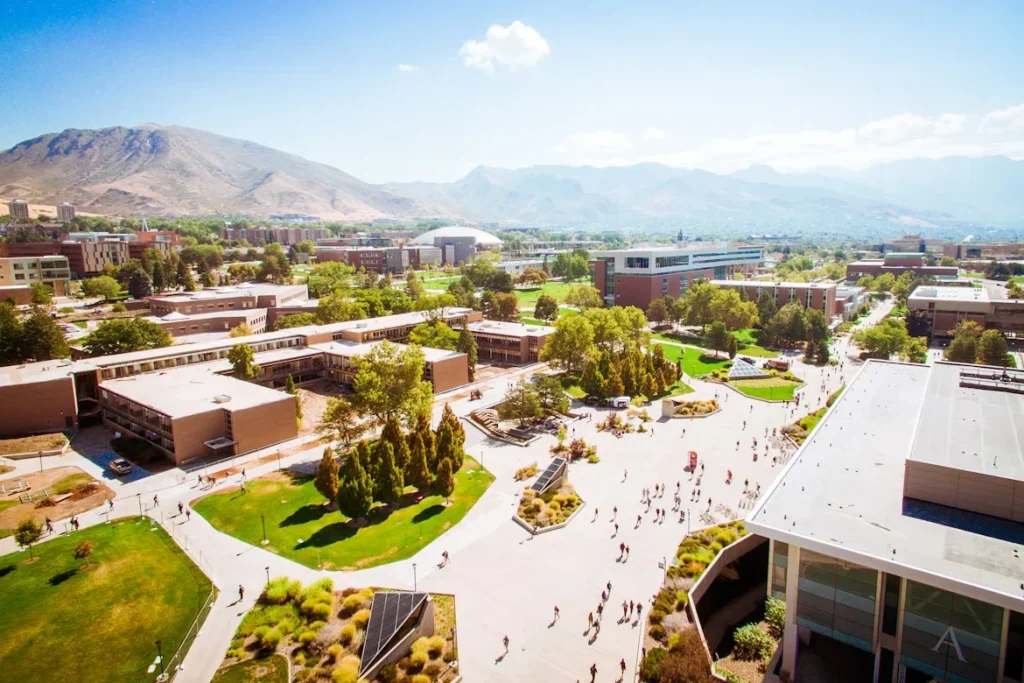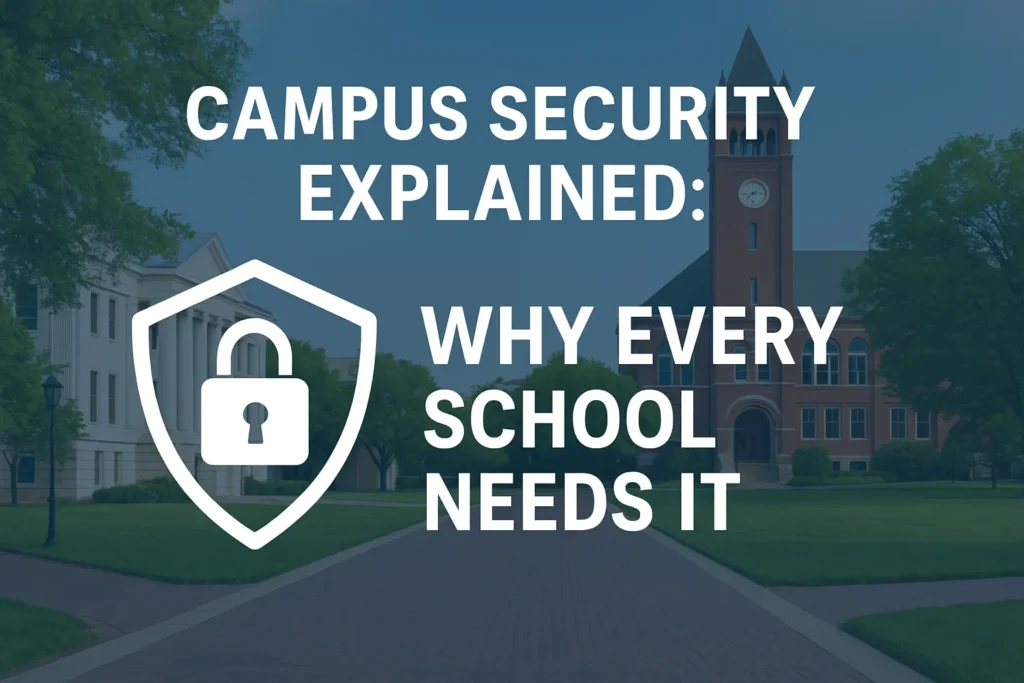Disclaimer: This article is for informational purposes only and does not constitute professional security, legal, or educational advice. Educational institutions should consult with qualified security professionals and legal advisors before implementing any measures discussed.
Have you ever questioned what it takes to secure a campus?
As someone responsible for protecting an ever-shifting and dynamic landscape, you know that security isn’t precisely about locking doors or placing a couple of cameras here and there.
College presents a unique set of challenges, including sprawling floor plans and high traffic volumes, as well as evolving threats in both physical and virtual environments.
Handling these challenges requires a multi-dimensional, strategic solution that incorporates sophisticated technology, concise messaging, and scalable infrastructure.
Whether reacting instantly in times of crisis or preventing cyber attacks on networked security systems, seconds matter.
Winning the competition is what matters most to the security of educational institutions today. Keep reading to discover five key reasons why prioritizing security is not just essential but vital for building a safe, responsive, and resilient campus environment.
1. Diverse Campus Layouts

As someone responsible for campus security, you know that educational institutions rarely follow a standard design.
Campuses comprise a combination of academic buildings, dormitories, playing fields, libraries, and open courtyards. Such varied layouts present a complex security environment where visibility and coverage are key concerns.
Traditional surveillance systems often fail to provide adequate coverage of these varied areas, resulting in familiar blind spots and increased exposure levels. With well-positioned wide-angle or multi-sensor cameras, however, you can deliver wide-area coverage in fewer units with the same ease of use and a general boost in coverage.
This also minimizes installation and maintenance costs, as well as simplifies monitoring for your security personnel. Furthermore, a versatile surveillance system allows you to accommodate evolving campus needs that stem from new buildings or restructuring.
By addressing the physical diversity of your campus with a scalable and strategic solution, you’re better equipped to provide comprehensive security coverage. In doing so, you’re creating a safer, more integrated community where students, faculty, and visitors can move about without compromise.
2. High Foot Traffic

You’re likely familiar with the constant ebb and flow of people across campus throughout the day.
From early-morning lectures to late-night library sessions, high foot traffic is a defining feature of educational environments. While this dynamic movement reflects a healthy, active campus, it also poses significant challenges for maintaining security.
The sheer volume of activity can make it difficult for traditional surveillance systems or even trained personnel to distinguish between normal behavior and potential threats. That’s where intelligent video analytics come in.
With the aid of real-time pattern recognition, behavior, and anomaly detection technology, you can proactively identify potential threats before they escalate into full-fledged issues. For example, the software can locate loiterers near sensitive areas or mark crowd anomalies at an event. Furthermore, intelligent systems can help reduce false alarms by filtering out routine behavior, allowing your team to focus on genuine security incidents.
As campus life continues to grow more dynamic, leveraging innovative technology that you’re not just watching but truly understanding what’s happening in every corner of your institution.
4. Communication Challenges

During a crisis, proper communication at the right time can make all the difference, and it is this burden you must weather. In the event of a medical situation, lockdown, or fire drill, mass messaging can be crucial for notifying all individuals on campus.
Big and noisy settings, however, tend to weaken the impact of traditional forms of communication. As a solution to this, you can integrate the use of audio systems, including outdoor speakers and intercom systems, and emergency call modes that enable you to send live messages to designated zones or the entire campus.
Additionally, two-way communication devices enable employees and students to report or seek assistance, providing feedback that notifies everyone and keeps them informed.
These systems may also be integrated with monitoring and access control systems, whereby an automated mechanism is triggered in situations of unauthorized entry or congestion, making an announcement.
In a situation where time is of the essence, with a campus-wide, transparently structured communication pattern, you can act quickly and efficiently, ensuring that the guidance of your choice reaches the right place at just the right time.
5. Cybersecurity Threats to Physical Security Systems
The more sophisticated digital tools you incorporate into your educational institution’s security structure, the more those systems become vulnerable to cyberattacks. Communication devices, access control panels, and surveillance cameras are usually networked. Thus, a hack on the network facility may pose a threat not only to data but also to the physical safety of staff and students. Inadequate cybersecurity would allow hackers to disable cameras, open doors, or access sensitive recordings.
To fortify your systems, it is essential to adopt practical encryption standards, implement regular hardware updates, and use secure access codes. This approach mitigates the effects of a possible breach by incorporating other types of defense, such as network segmentation and multi-factor authentication. Additionally, coordination with IT teams warrants that the physical and digital security plans work in harmony.
Cybersecurity is no longer a unique issue in the modern day, as it has become an integral part of campus security. Ultimately, vigilance and proactivity enable you to prevent vulnerabilities before they become realities, giving you the advantage of having a solid, stable, and resilient stance throughout the entire security system.
6. Incident Documentation and Liability Protection
You understand that when an incident occurs, whether it’s theft, vandalism, harassment, or an accident, having clear, reliable evidence can be critical. Video documentation not only helps identify those responsible but also protects your institution from legal liability.
High-quality surveillance footage can support law enforcement investigations, validate insurance claims, and provide evidence to defend your actions in court if necessary. However, for this documentation to be adequate, it must meet specific standards. This includes capturing high-resolution images, ensuring proper time-stamping, and maintaining secure storage with easy retrieval.
In many cases, institutions have faced legal or reputational damage due to gaps in evidence or poorly maintained systems. By investing in robust recording technology and organized archival processes, you certify that every critical moment is accurately captured and preserved.
Additionally, advanced search and playback tools enable your team to investigate incidents promptly and respond effectively. In this way, reliable video evidence becomes not just a tool for safety but a cornerstone of accountability and institutional integrity.
Conclusion
In a world where safety is paramount, securing your campus is no longer optional; it’s essential.
From complex layouts and high foot traffic to cyber threats and the need for real-time communication, prioritizing security systems enables you to create a safe, responsive, and resilient environment.
By embracing innovative technology and proactive strategies, you check that your campus remains a secure place for everyone. Protecting your community starts with the right tools. Act now!











